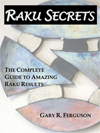|
- Article - Site Navigation Home Raku Artist Bio Raku Gallery Free Raku Glazes Raku Define Raku Links Raku Articles Raku Books |
Robert Piepenburg Workshop II - HandbuildingLast month I covered the wheel techniques that Robert Piepenburg used during a November workshop. This month I cover the handbuilding techniques he shared. Piepenburg basically creates two types of hand built sculpture - the totem and the slab abstracts. The totems are tall narrow structures usually composed to two or three separate pieces (for ease of firing, shipping, etc.). He creates the base by taking a fat coil and inserting a broom handle down the middle of the coil and then rolling the coil using the handle. This thins the walls and creates a long cylindrical column. The coil is typically rolled with a little more force on one end to create a tapered cylinder. Then additional solid coils, clay rods and abstract forms are added to create the upper portion of the totem. Piepenburg also creates tabletop abstract slab forms that appear much like natural granite, slate, or rock slabs. He creates these using fairly thick (1 inch) and fairly stiff slabs. The slabs are scored and then placed along the edge of a table to snap into pieces. This starts the formation of a very organic edge. Piepenburg further enhances the edge and sides by using a fettling knife to carve additional creases, and to slice and pry chunks out of the surface. The results are slabs that look like weathered slate. These slabs are then joined together, but not using the traditional score and slip method. He uses small nails pushed into each side. Two nails are typically used at each connection point, each angled in an opposite direction to create a sort of X pattern in the joint that is actually quite strong. Using slip to hold the slabs together via a very small surface area would never work. Piepenburg also talked about his wife's (Gail Piepenburg) hand build Triptychs (3-part) and Diptychs (2-part) wall art. The pieces are created to look very thick but are actually built over a foam pad creating a hollow back. The face of each form are then cut, scored, layered with additional slabs, ripped, etc. to create a very organic and "active" piece. Some pictures from the workshop can be seen at: |
||
|
Books
Learn Dozens of Hints, Tips and Techniques in the free monthly newsletter Just
Raku Privacy Policy - Your email address or other personal information will only be used for this newsletter. It will never be given, rented, or sold to any other party for any other purposed. |
||
|
Gary R. Ferguson - Raku Artist (c) Copyright 2005, Gary R. Ferguson |
||



